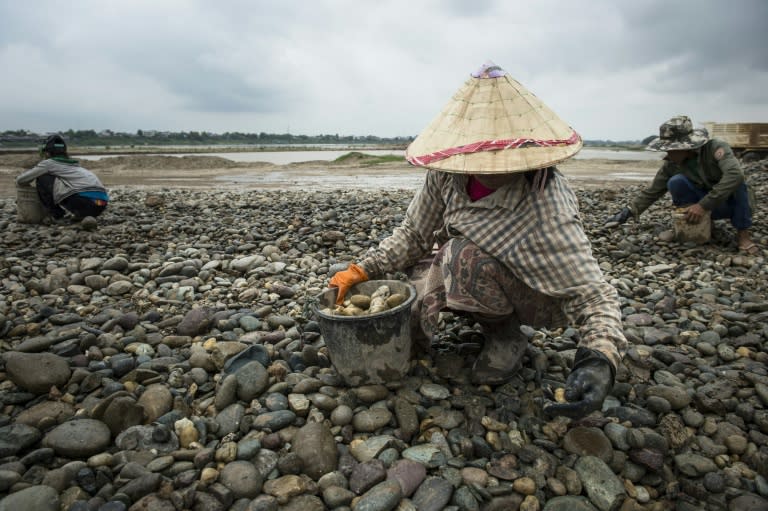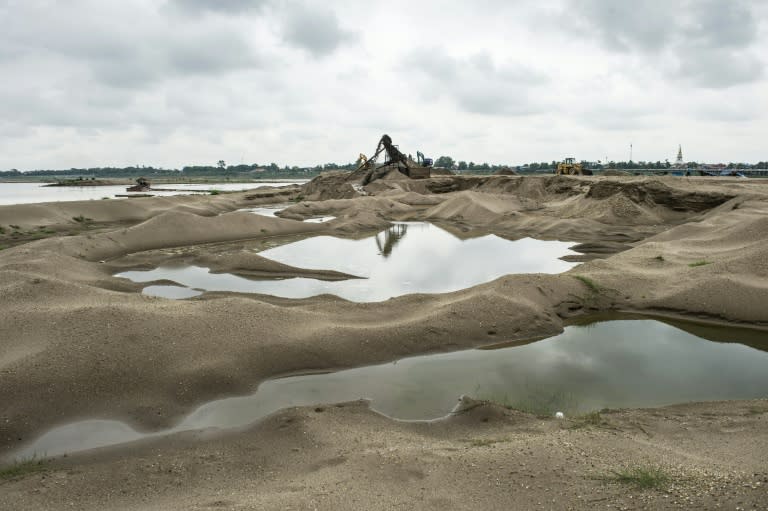Grain drain, Laos' sand mining damaging the Mekong
Grain by grain, truckload by truckload, Laos' section of the Mekong river is being dredged of sand to make cement -- a commodity being devoured by a Chinese-led building boom in the capital. But the hollowing out of the riverbed is also damaging a vital waterway that feeds hundreds of thousands of fishermen and farmers in the poverty-stricken nation. "Today, it's more complicated for us to go fetch water for crops," Deam Saengarn told AFP from the muddy river's shores, describing how its gentle slopes have given way to steep embankments. The 36-year-old mother of two captures Laos' development conundrum: she depends on $10 daily wage from a sand extraction firm, but also relies on the very river she is helping to gouge. "We really need this water," she added wistfully, dripping with sweat as she separated stones from the mountains of sediment piled on the shore. All around her, industrial pipes and excavators suck up the Mekong's floor, carving moon-like craters into the bed of a river that winds through most of the landlocked nation. It is a familiar story in a country whose natural resources have been steadily plundered by businesses -- many of them Chinese -- under the gaze of communist leaders who brook no dissent but welcome foreign cash. Sand, an unflashy and seemingly infinite resource, is the chief ingredient in cement and the hidden hand behind the explosion of cities worldwide. China is also its top consumer -- devouring more than 60 percent of the global output and using more sand in four years than the United States did in the entire 20th century. Dredging has been taking place for years along the Mekong, but the industrial scale is relatively new to Laos, where the grains pave a flurry of new construction projects in the country's sleepy capital, many of them funded by Chinese firms. - 'River needs sand' - "We now have many Chinese clients. They are constructing huge buildings in Vientiane, so they need a lot of sand and pebbles," said Air Phangnalay, who helps run an extraction company in Laos. China is the largest source of foreign investment in neighbouring Laos. Chinese businessmen loom large in the isolated nation and have zeroed in on its array of timber and mineral resources -- often to the dismay of an impoverished populace with few outlets to air grievances. Experts say the uptick in sand mining, a lesser-known resource grab, is harming the delicate ecosystem of a river some 60 million people across the region depend on. The 4,800 kilometre Mekong, which starts in southwestern China and empties out in southern Vietnam, is the world's largest inland fishery and among the most biodiverse rivers on the globe, according to World Wildlife Fund (WWF). It naturally produces around 20 million tonnes of sediment a year, but is now seeing twice that much extracted annually, according to the latest research to which WWF contributed. Most of the dredging is taking place in Cambodia and Vietnam, but the pace of mining is picking up speed in Laos -- an opaque country where big businesses can swallow up resources with minimal scrutiny. Marc Goichot, from the World Wildlife Fund, said the rate of mining along the Mekong has become "unsustainable" and is setting the stage for especially dire damage downstream. "The river needs the sand to be transported from upstream down to the delta to fight against salinisation and encroachment of the sea in this crucial area for agriculture," he told AFP. Farmers along the Mekong's vast delta in Vietnam are already battling the worst saline intrusion rates in decades, thanks to severe droughts that have parched rice paddies across the region. - Troubled waters - An official from Laos' Ministry of Public Works conceded the dredging "affects the Mekong river and its ecosystem structure". But the official declined a full interview or to provide figures on how much sand has already been extracted. Without strict regulation, the dredging will trigger erosion patterns that could take decades to reverse, according to the UN's environmental agency. "The problem is that we have long believed that sand was an inexhaustible commodity," Pascal Peduzzi, told AFP, adding that rivers across the world are now under threat from a global spike in extraction. Yet sand mining is not the only effort to monetise the mighty Mekong -- while dangerously disrupting its flow. There are already 12 dams built or under construction on the river's upper reaches in China, with at least seven more planned. Another nine are underway or planned in Laos, plus two more in Cambodia. Environmental groups strongly oppose the stoppages, which they say hamper crucial fish migrations, block key sediment transfers and threaten to flood lands that tens of thousands of people call home. It is damage that will only be compounded by a free-for-all race to scoop up the river's sand. "The river has changed a lot. Here, the banks are collapsing. This did not happen before," a Laos fishermen told AFP as he drew his nets, declining to give his name in a country where many fear speaking out. "It requires us to go further to fish. It's not good for us."





